BRITISH ART IN SIX DECADES
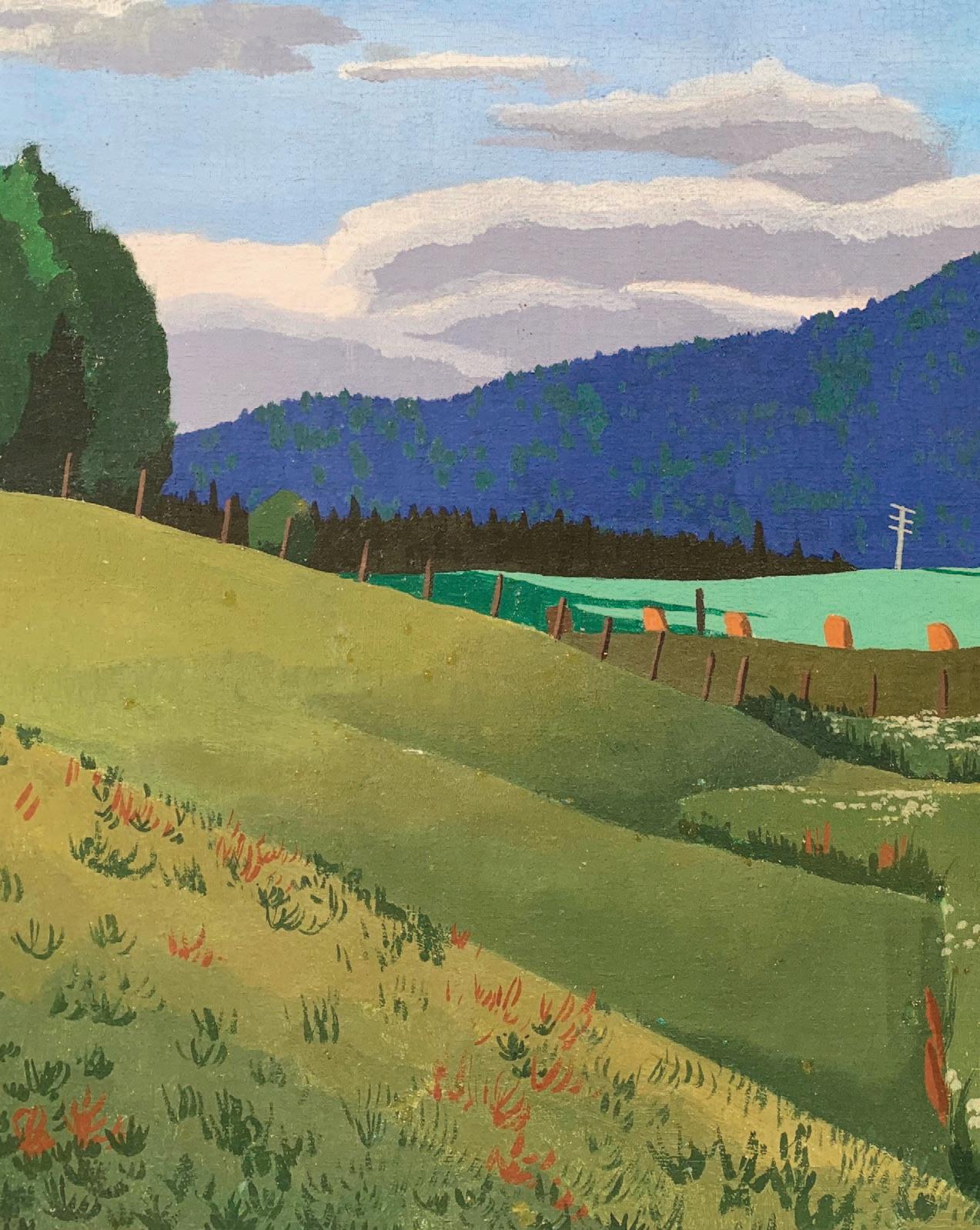 HARRY MOORE-GWYN
BRITISH ART
HARRY MOORE-GWYN
BRITISH ART
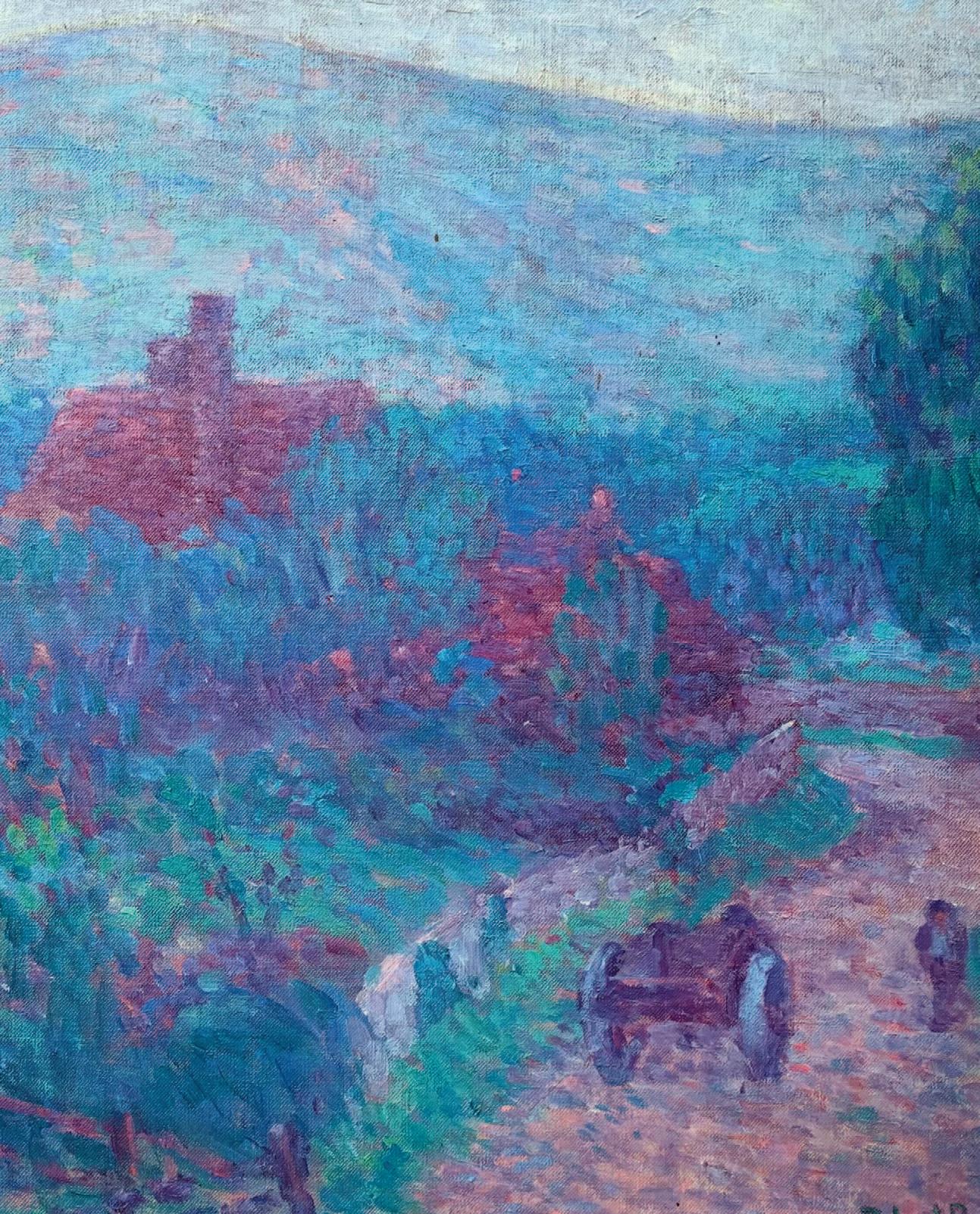


 HARRY MOORE-GWYN
BRITISH ART
HARRY MOORE-GWYN
BRITISH ART


(1890 - 1950)
Catalogue to be held in conjunction with an exhibition at
Ground Floor, 6 Mason’s Yard, Duke Street, St James’s, London SW1Y 6BU
Front cover: Harald Sund (1867-1940) [Detail of cat.23]
Rear cover: Walter Bayes, RWS (1869-1956) [Detail of cat.24]
Opposite page: Robert Bevan (1865-1925) [Detail of cat.18]

It is of course impossible to present anything approaching a comprehensive survey of British art of the first few decades of the twentieth century. Here we are just scratching the surface There are many narratives with an equally different cast of leading protagonists. Despite this and despite the tumultuous years these decades represent in the context of European culture, the increasing dominance of Post War and Contemporary art has almost made art from these years neglected. So this is our survey. It is primarily one of representational art and we have generally excluded abstract art from this period which would be a catalogue in its own right.
The first thing we have attempted to do, is to move the focus away from the artificial break of the new century. As this survey argues, the seeds of modern art were sown well before 1900 and particularly in the 1890s. Edward Burne-Jones, who in the first drawing in our catalogue looks back to Italian art of the Quattrocento, also looks forward to Italian-inspired British art by British artists of the 1920s and 1930s. Robert Bevan, who would go on to form the Camden Town Group in 1911, was in Pont Aven in the 1890s, meeting Gauguin and being inspired by the Post Impressionists and their radical colour and invention.
The Camden Town Group and its members and former members are central to this catalogue If they seem traditional to us today, in 1911 they seemed radical, with many creating great work in the previous two or three decades to that. Many of their members, amongst them here Charles Ginner, Walter Sickert, Harold Gilman, Walter Bayes, Spencer Gore and Henry Lamb, remained key figures in the representational tradition in modern British art. Another important overriding influence was the position of the great British art schools of this period. From the Slade came Augustus John, Rupert Lee, Dora Carrington and (perhaps above all) Paul Nash who would help mould an entire generation of artists in the inter-war years.
At the tail end of our survey is work by members of the Euston Road School, with the work of Lawrence Gowing, William Coldstream, Victor Pasmore and others helping to steer the direction of figurative art of the post War period. A final mention must be made to the work of sculptors. This is our first catalogue to feature sculpture significantly – an important parallel to late Pre Raphaelite art existing in artists of the New Sculpture movement and of inter-war modernism in sculptures by artists such as James Woodford.
There are no consecutive six decades that are more exciting in the history of British art. We hope therefore you find something of interest here and that you will visit the accompanying show in our gallery in Mason’s Yard.
Harry Moore-Gwyn (May 2023)
CAT. 1
Sir Edward Coley Burne-Jones Bt., ARA, RWS (1833-1898)
Female Nude, a study for “The Golden Stairs”
Silverpoint and white chalk on grey prepared paper, 28 by 21 cm (11 by 8 ¼ ins)

Provenance: from the artist to his granddaughter Angela Margaret Thirkell (née Angela Margaret Mackail); by descent to Graham Campbell McInnes (Graham Thirkell) then given to his son
Simon McInnes in 1969
Exhibited: London, Burlington Fine Arts Club, Sir Edward Burne-Jones, Bart., 1899, no. 204.; National Gallery of Canada, Ottawa NGC (Musée des Beaux-Arts du Canada, Ottawa MBAC) on loan in 1980 (Jones L-2.3)
The present work forms part of a series of silverpoint drawings that are connected with Burne-Jones’s major Italian-inspired painting The Golden Stairs (1876-1880) (Tate Gallery, acc.4005). The painting resulted from a trip to Italy in 1871 and coincides with a period sometimes referred to as the artist’s Florentine phase. The technique in this drawing was inspired by Florentine art of the Quattrocento, including the work of artists like Filippino Lippi. A number of related studies were given to the Ashmolean Museum as part of a bequest from Helen Mary Gaskell in 1939, see for example Study for “The Golden Stairs” (The Visitors of the Ashmolean Museum, Oxford (acc.1939.15)). Like this drawing those works are notable for their grey prepared background which complements the greys and whites produced as a result of the application of the silverpoint medium. This sensuous nude is a study for the prominent bending figure to the centre right of the finished painting. In common with other studies by BurneJones, the artist made the preliminary study as a life drawing prior to adding the fabric of the clothing.
CAT. 2
Sir Edward Coley Burne-Jones Bt., ARA, RWS (1833-1898)

Inscribed with title u l.: King Pharaoh's Dream
Pencil with black and white chalk on light brown paper, 12 by 16 cm (4 ¾ by 6 ¼ ins)
Provenance: The Drawing Shop, New York; with Robert Holden in 1993
This is a proposed illustration for J.W.McKail's project Biblia Innocentium which was published by the Kelmscott Press in 1892. McKail was Burne-Jones's son-in-law and the artist had intended to produce some 200 illustrations for the work but they were never completed and the book was published without them. Some were later reproduced as woodcuts by Robert Catterson-Smith in 1902.
CAT. 3
Henry Holiday (1839-1927)

Oil on paper, 32.5 by 49 cm (12 ¾ by 19 ½ ins)
Music was a central part of Holiday’s life both as a concert-goer, singer (performing for some time in the Bach and Richter Choruses) and even a composer with several songs to his name. Unsurprisingly musical subjects found their way into his art sometimes as allegorical and genre subjects and elsewhere through his many illustrations to concert programmes. Here, his primary love was the music of Richard Wagner. His drawings appear in programmes for Wagner operas for the impresario
Alfred Shulz-Curtuis in the mid-1890s. It is possible that this painting was an idea for a similar programme from the period.

Painted plaster relief, 96.5 by 56 cm (38 by 22 ins)
Goscombe John was the pre-eminent Welsh sculptor of the turn of the twentieth century. He was a Gold medallist at the Royal Academy schools in the 1880s and in the early 1890s took a studio in Paris where he studied under Rodin. He was a prolific creator of public sculpture, with his work including two great First World War memorial groups The Response 1914 in Newcastle-upon-Tyne and the Port Sunlight Memorial. These are widely considered to be amongst the finest large scale sculptural groups on any British monument. The present work probably dates from the mid to late 1890s. It can be compared to sculptures like the narrative copper panel The Glamour of the Rose which was exhibited at the Royal Academy in 1896. At this date John was under the influence of the New Sculpture movement, exemplified by the Romantically expressive work of artists like Sir Alfred Gilbert. He was a fine modeler in a plaster and would regularly paint these reliefs to imitate bronze. Several similar works in this medium are amongst his early exhibits at the Royal Academy.
CAT. 5
Robert Bevan (1865-1925)
A Breton Procession, c.1893
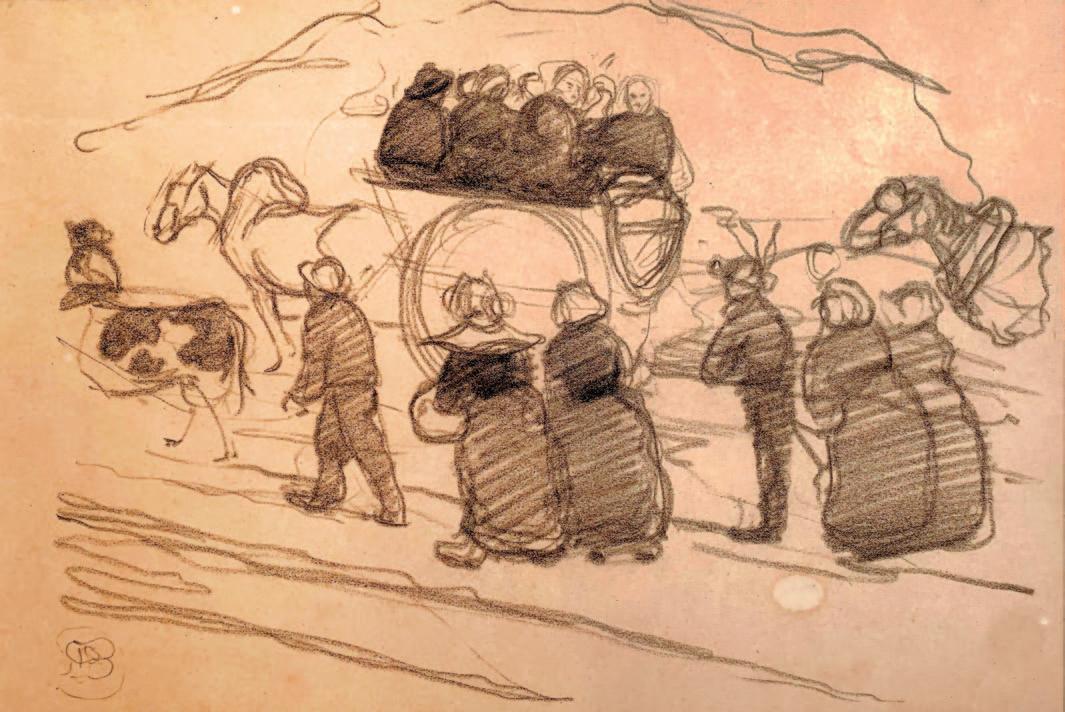
With the artist’s monogram l l.: RPB and with the artist’s studio stamp (verso)
Black crayon, 33.5 by 51 cm (13 by 20 ins)
Bevan made trips to Pont Aven in Brittany in 1890-1 and again in 1893-94. In his second visit he befriended the colony’s most famous resident Paul Gauguin who dedicated a monotype to him in 1894. Slightly older than some of his contemporaries in the Camden Town Group (who would form some twenty years later) he was one of the first of them to visit France and engage with Post Impressionism both in its vivid colouring and undulating draughtsmanship – the latter of which is evident even in monochrome sketches like these.
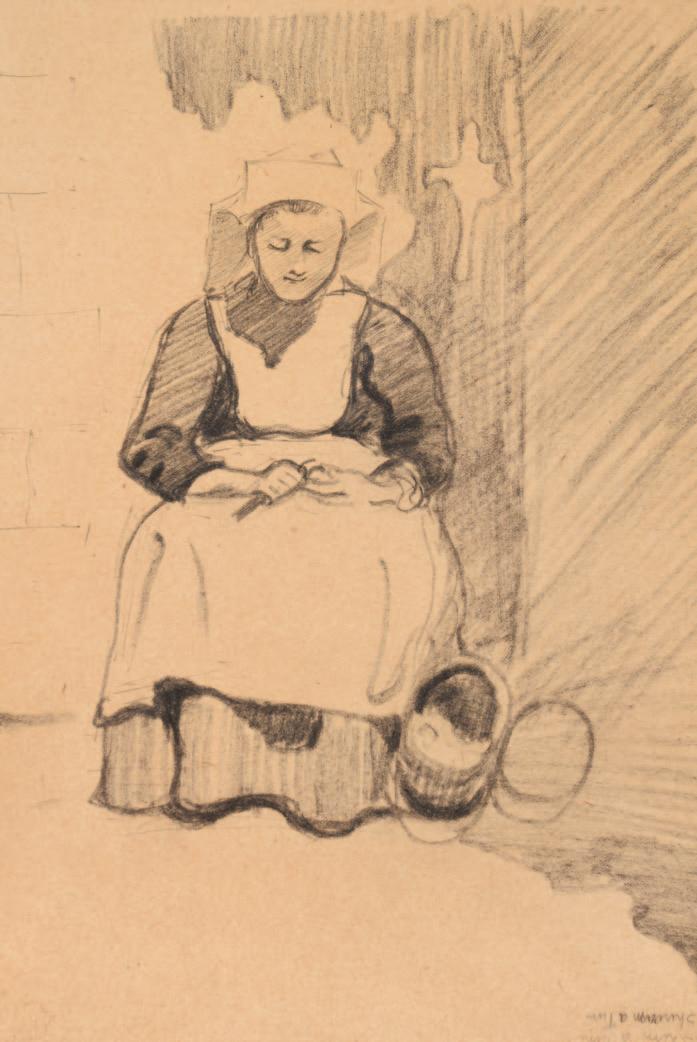
CAT. 7
Sir George Clausen, RA, RWS (1852-1944)
Study for Bird Scaring, c.1887
Signed with initials l.r.: GC
Watercolour and bodycolour, 23 by 22.5 cm (9 by 9 ins)
Provenance: Mr. Ralph Fastnedge, DFC (Curator of the Lady Lever Art Gallery, Port Sunlight); Thence by descent
The painting Bird Scaring (Private Collection) was one of Clausen’s most direct early rural social-realist works. In it a young farm boy, armed with slabs of wood (to be clattered together to ward off the crows) makes his way out into the fields in his tattered clothes. This small but intense watercolour is a study for the final work.
Clausen was drawn to the subject again in 1896 in a version which places the young boy head-on in a more extensive landscape (Harris Art Gallery, Preston, no.P74).
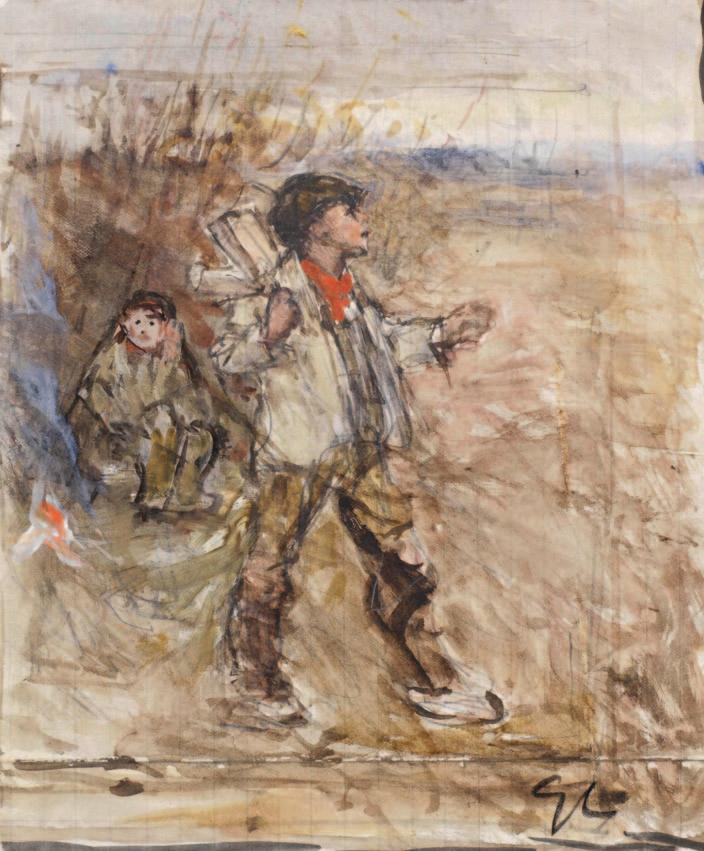
CAT. 8
Augustus John, OM, RA (1878-1961)
A Seated Female Nude
With original faded certification label in the hand of the artist’s son Caspar (to reverse of original backboard)
Charcoal, 61 by 45 5 cm (24 by 18 ins)
Provenance: acquired by the previous owner directly from the artist’s son, Caspar John
Rebecca John has suggested a date of circa 1897 for the present work, a period that coincides with John’s time studying at the Slade. John was widely considered to be the star pupil at the Slade school of art in the 1890s at a time when the school was enjoying a golden period under the professorships of Henry
Tonks and Fred Brown. In 1898 John won the Slade prize for his work Moses and the Serpent. Life drawing was an essential part of Slade training and the impressive scale of this charcoal drawing marks it as one of John’s largest known works in this genre.

CAT. 9
Alfred Bertram Pegram (1873-1941)
The Head of a Young Man
Signed: A.Bertram Pegram
Silvered bronze on a green marble base, height 11 cm (4 ½ ins) (not including base)
Pegram entered the Royal Academy Schools in the mid-1890s where he won a number of prizes. He was an accomplished sculptor working in bas relief and on medals as well as free-standing sculpture and portrait busts. His work, like this sensitive portrait bust, is firmly in the tradition of the New Sculpture Movement which held significant sway at around the turn of the twentieth century.

CAT. 10
Bertram Priestman, RA (1868-1951)
Ebb tide, Suffolk Estuary
Signed and dated: B.P./1896
Oil on canvas, 32 by 47 cm (12 ½ by 18 ½ ins)
Exhibited: London, Royal Academy, Summer Exhibition, 1898, no.155
Literature: P.Lawson/J.Rennie, Bertram Priestman Exhibition Catalogue, Bradford Art Gallery/Ferens Art Gallery Hull, 1981, cited in introduction
The present work forms part of a series of harbour paintings that Priestman embarked on in the mid 1890s and which dwell on the grandeur of resting or abandoned ships. The surrounding landscape is likely to be the Suffolk and Essex estuaries near where he had settled a few years earlier.

Priestman’s landscapes, whether in their depictions of tugs, boatyards, or steamers carry the constant reminder of man’s effect on the landscape. Such details contribute to him being counted amongst the most original artists to bridge the divide
between Victorian and Edwardian painting. In his day he exhibited equally alongside figures like Philip Wilson Steer and Henry Tonks. Like those artists he looked beyond his own shores to the modern influence of Whistler and it is no coincidence that he enjoyed success initially exhibiting at the New English Art Club during its heyday. Later he included amongst his pupils the young Edward Seago on whose work he had a profound influence.
CAT. 11
Herbert Dalziel (1853-1941)
Fields on a Sunlit Day
Signed and dated l l.: Herbert Dalziel/1896
Oil on card, 15 by 20 cm (6 by 8 ins)
In the catalogue for his landmark 1995 Barbican show Impressionism in Britain, Kenneth McKonkey wrote of Dalziel’s later work: “In an extraordinary departure, around 1910, Herbert D alziel abandoned his conservative style and produced a number of jewel-like landscapes which adopt a sophisticated divisionism the sense of atmosphere and weird luminosity draws comparisons with contemporary photography and the mystic landscapes of Khnopff.” The
present work, however, is evidence of a similar luminosity in his painting well-before 1910 at a time where he was starting to exhibit at the New English Art Club (having recently been elected a member). It is likely that it was here that he came to know the American painter James Abbott McNeill Whistler who remained a strong influence. D alziel was the son of Thomas Dalziel, part of the important Victorian family woodengraving business known as the Brothers Dalziel

CAT. 12
Herbert Dalziel (1853-1941)
Nocturne
Signed and dated l.r.: Herbert Dalziel/1915
Oil on canvas laid to board, 15 by 20 cm (6 by 8 ins)

CAT. 13
John Macallan Swan, RA (1846-1910)
The Head of a Bear
Signed with initials: JMS
Bronze with a dark brown patina on a green marble base, height 6.5 cm (2 ½ ins) (not including base)
Swan was a remarkably versatile artist working as a painter and pastelist as well as a sculptor. This is in no small part accounted for by a training that took him to the studios of both a great painter (Jean-Léon Gérôme) and a great sculptor (Emmanuel Frémiet) in Paris. His 1878 work The Prodigal Son
was acquired by the Chantry Bequest in 1878 and is now in Tate Britain. As a sculptor, it is for his animal bronzes that he is best known, works that are characterised by their sense of movement and highly tactile modelling.

CAT. 14
Edward Reginald Frampton, ROI (1873-1923)
Signed l l.: E.Reginald Frampton
Tempera, 25 by 35 cm (9 ¾ by 13 ¾ ins)
Many of Frampton’s landscapes date from slightly later in his career and were painted when his literary, allegorical and figure subjects were beginning to go out of fashion. However, the Arts and Crafts influence that pervades those paintings
remain in evidence in the landscape works which convey the same formal, decorative style as they do in the background to his larger figure pictures. Throughout is the influence of one of his artistic heroes, Edward Burne-Jones.
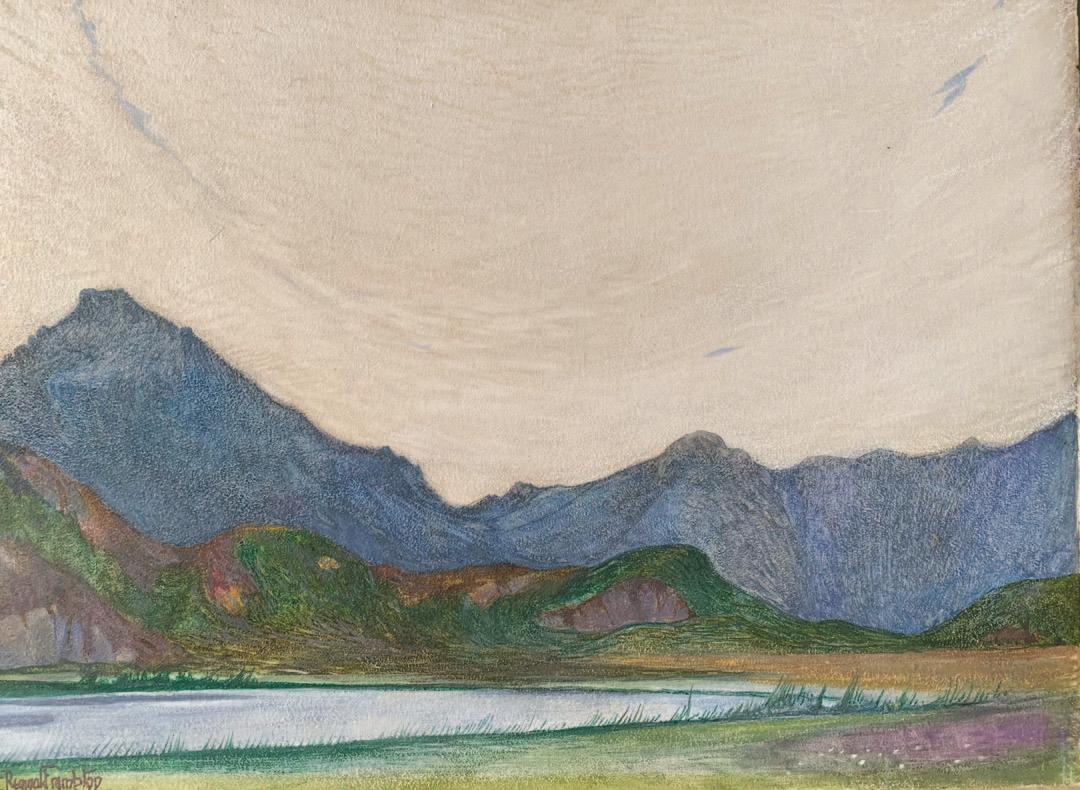
CAT. 15
ran
Bronze on a Siena marble base, height 35 cm (13 ¾ ins) (not including base)
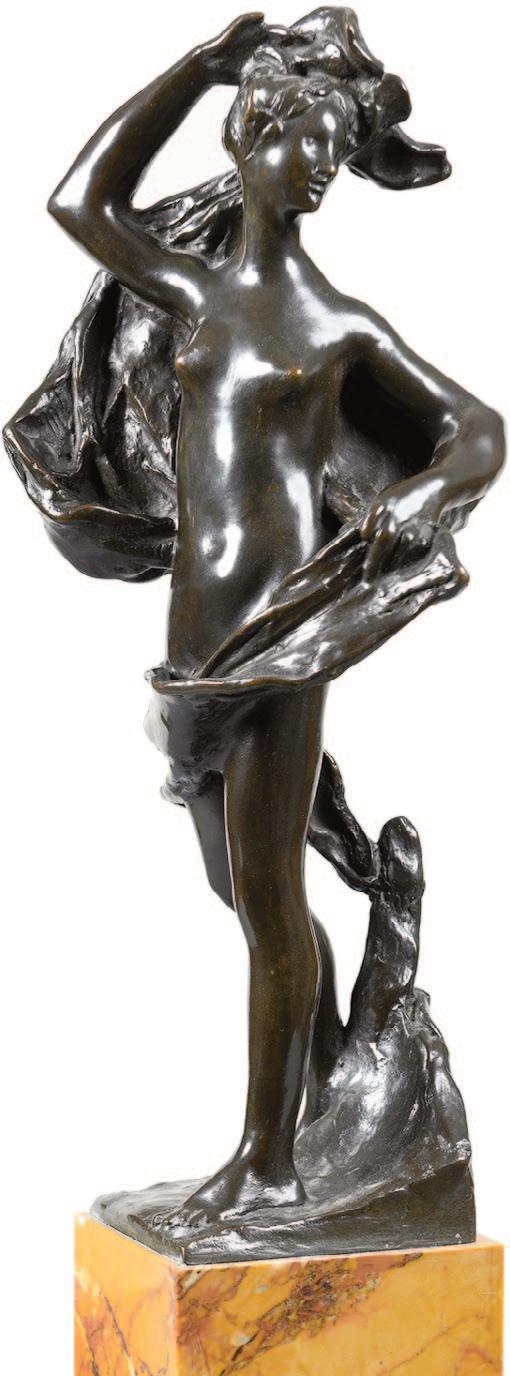
Provenance: probably Charles Handley Read (1916-1971)
Literature: British Sculpture 1880-1915: A loan exhibition of sculpture and medals sponsored by the Victorian Society, The Fine Art Society, London 1968, illus. fig. 199
The present work originally formed part of a set of bronze sculptures depicting the Four Seasons (see fig.1. below) which was exhibited the Fine Art Society’s landmark show British Sculpture 1880-1915 in 1968. The complete set was originally in the collection of the great writer and collector Charles Handley Read and can be dated to c.1906.

CAT. 16
Herbert William Palliser (1883-1963)
Signed in cast to reverse: Palliser Bronze mounted on a Hopton Wood stone base, 28 cm (11 ins) high (42 cm (16 ½ ins) (including base))
A photograph of what appears to be the same cast on an identical stone base was in the collection of contemporary photographs of sculpture bequeathed to the Victoria and Albert Museum in 1938 by the writer William Kineton Parkes (acc. 3455-1938). Palliser’s work straddles the styles of Edwardian sculpture and Art D eco and he was a prolific architectural sculptor with work including that in the City of London, on King William Street and Vintner’s Place and pediments for Victoria House (1921-1934) opposite Southampton Row. He was also well known as an animalier and portrait sculptor and taught at the Royal College of Art between 1931 and 1948.

CAT. 17
Robert Bevan (1865-1925)
A Sussex Farm, c.1905
Bears title on earlier frame: Houses and Fields/no.51
Oil on board, 25 by 31 cm (9 ¾ by 12 ¼ ins)

Provenance: the Estate of R.A.Bevan (the artist’s son)
The present picture dates from a period when nearly all of Bevan’s landscape paintings depicted scenes in Poland, the home of the artist’s wife Stanislawa de Karlowska Architecturally however the farm buildings appear to be English and so would suggest a Sussex subject – the part of England that drew Bevan from around 1905 (and the location of the Bevan family’s home). His paintings from this period
are often smaller in scale but strong in colour and notable for their loose brush strokes. Such works assimilate the influence of some of the artist-friends Bevan had met whilst studying at the Académie Julian in Paris, including Vuillard, Bonnard and particularly Paul Serusier. We are grateful to Patrick Baty for his assistance in researching cat.nos 17 and 18.
CAT. 18
Robert Bevan (1865-1925)
A Wagon on the Street at Kingston, Sussex, c.1906
Signed l.r.: Robert Bevan
Oil on canvas, 47 by 54.5 cm (18 ½ by 21 ins)
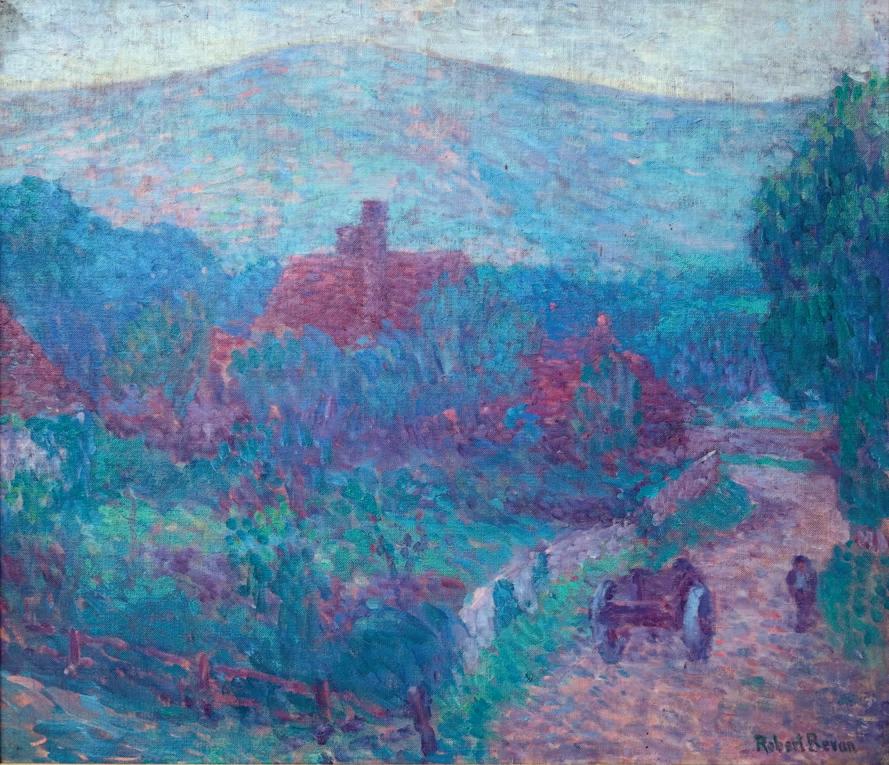
Provenance: the Estate of R.A.Bevan (the artist’s son)
Literature: Alice Strang, From Sickert to Gertler Modern British Art from Boxted House, p.64 (visible on the wall to the left of the fireplace in interior photograph of the Drawing Room at Boxted House)
Bevan spent two summers in 1905 and 1906 in a cottage called St Ives in the South Downs village of Kingston near Lewes in Sussex. It was a landscape that was extremely familiar to the young artist, his family estate being in nearby Horsgate. It also coincided with a slight shift in Bevan’s style towards a more divisionist technique of painting that assimilated the influence of the Impressionists and had been brought to England by Camille Pissarro’s son, Lucien (see also cat.19 for a comparable work by Bevan’s fellow Camden Town painter Spencer Gore). The distinctive farmhouse at the centre of this painting with its bright red-tiled roof appears in other works
by Bevan from the period, for example in the painting A Small Southdown Farm now in the collection of Colchester and Ipswich Museums (no.R.1964-130). These Sussex paintings were some of the first mature works Bevan painted outside Poland, the home of his wife Stanislawa de Karlowska. Bevan was an artist whose style never stopped changing and developing, but some of the themes and motifs in this picture (including the figure and cart depicted on a steep country road) appear in the artist’s work for the rest of his working life. The majority of these Sussex paintings were shown at his exhibition at the Baillie Gallery in 1908.
CAT. 19
A Yorkshire Landscape, c.1907

Signed on the canvas (to reverse on stretcher): S.F.Gore Oil on canvas, 46 by 61 cm (18 by 24 ins)
Provenance: Anthony D'Offay; Mr and Mrs Alan Fortunoff, New York; the Fine Art Society
Literature: Wendy Baron, The Camden Town Group, Scolar Press, London, 1979, no.32, p.150, illustrated p.151
Gore was arguably the most significant figure in the Camden Town Group as well as being the leading force behind the foundation of both the Fitzroy Group and the Allied Artists’
Association. Indeed, despite his untimely death of pneumonia in 1914 aged only thirty five, Gore was at the heart of some of the most radical and forward-looking British art movements of the pre-First World War period. The present work was probably painted on a painting trip that Gore made to Brandsby Yorkshire in the summer of 1907 with fellow painters Albert Rutherston and Walter Russell. It is a fine example of a work that demonstrates the artist's newly-
acquired divisionist painting technique (painting separately with small dots and strokes of colour). Wendy Baron refers to this technique on her entry on this painting in her book on the Camden Town Group (see literature above): “He began to build his pictures up constructively, using separate small touches of one colour at a time… His colours were often brilliant; orange, violets and greens are scattered in an ordered harmony that nonetheless retains a lively, even spontaneous flavour” (see literature, op cit, p.150). He had recently learned this method of painting from his fellow painter Lucien Pissarro.
CAT. 20
Arthur Hacker, RA (1858-1919)
Children in the Fields at Sunset

Signed and dated l.r.: Arthur Hacker/1909 Oil on panel, 26 by 35 5 cm (10 ¼ by 14 ins)
Hacker’s work took a strikingly different direction just prior to his election as a Royal Academician in 1910. Having previously made his reputation as a flamboyant portraitist and subject painter in a grand late Victorian-Edwardian style, this later work adopted a softer, more painterly style that is more about mood and tone than exacting detail. Such works are Hacker’s response to artists like the American painter James McNeill Whistler. Whistler had died in 1903 but his influence on British art extended from the 1880s to well beyond his death into the first decade and a half of the twentieth century.
Left: [Detail of cat.21]
CAT. 21
Harold Gilman (1876-1919)
In the Drawing Room at Snargate Rectory
Signed l.r.: H.Gilman
Oil on canvas, 54 by 44 cm (21 ¼ by 17 ¼ ins)
Provenance: The Estate of the Artist, from whom acquired by Lord and Lady Walston in 1955; Their sale, Christie's London, 6th June 2003, lot 14
Exhibited: Colchester, The Minories, Harold Gilman, 1876-1919, An English Post-Impressionist, 1st - 29th March 1969, cat. no.10, illustrated, with tour to The Ashmolean Museum, Oxford and Graves Art Gallery, Sheffield (as Interior); Stoke on Trent, City Museum and Art Gallery, Harold Gilman 1876-1919, 10th October - 14th November 1981, cat. no.8, illustrated p.44, with Arts Council tour to York City Art Gallery, York; Birmingham Museum and Art Gallery, Birmingham, and Royal Academy of Arts, London (as Interior); London, Christie's, The Painters of Camden Town, 1905-1920, 4th - 24th January 1988, cat. no.28 (as Interior).
Literature: Maureen Connett, Walter Sickert and the Camden Town Group, David & Charles, Newton Abbot, 1992, p.45, illustrated (as Interior (showing Grace and the Children)).
The rectory at Snargate on Romney marsh in Kent was the home of Gilman's father who was rector of the parish there until his death in 1917. Several important early interior scenes were executed by Gilman there including the present work, Edwardian Interior (Tate Britain) and Interior (Southampton Art Gallery). This painting’s location has traditionally been identified as the nursery, although the room depicted, with its carefully arranged ornaments and pictures, is almost certainly the rectory’s drawing room. The scene depicts the artist's first wife Grace with her back turned to us as she stokes the fire.
To the front of the composition is the maid, Sarah, reading a book with Gilman's younger daughter Hannah (b.1905). Gilman’s interior scenes are some of the most remarkable in British art from the first two decades of the twentieth century. The earlier subtle subdued influences of artists such as Bonnard which help lend this painting its beautiful “golden” tone, would later give work to the stronger colours of post impressionism seen in his work of the 1910s. We are grateful to James Beechey for his assistance.


CAT. 22
Adrian Stokes, RA, RWS (1854-1934)
Signed l l.: Adrian Stokes
Oil on panel, 20 by 26 cm (8 by 10 ¼ ins)
Many of Stokes's most successful later landscapes focus on the landscape of the Tyrol on the Austrian/Italian border and provide a vibrant and highly decorative record of the flora and fauna throughout the changing seasons.

CAT. 23
Harald Sund (1867-1940)
Signed and dated (in Roman numerals) l.r.: Harald Sund/MCMXIII (1913)
Tempera on canvas, 52 by 61 cm (20 ½ by 24 ins)

Exhibited: Brighton Art Gallery, Exhibition by the Camden Town Group and others, December 1913-January 1914, no.25
Sund and his wife Renée Finch began exhibiting with the Camden Town Group towards the end of 1913 just prior to its merger to form the London Group. His name first appears as an exhibitor at the Doré Galleries in October of that year in a show curated by the influential critic Frank Rutter. The exhibition also contained work by painters who had been influenced by the Futurist style, amongst them important early pictures by Nevinson. Sund was subsequently present at the meeting in November 1913 which resulted in the formation of the London Group, of which he was consequently a founder
member. Despite Sund’s place in the heart of the London art scene at this date, his work as a painter is extremely rare and is hardly ever seen on the open market. This strongly colourful and decorative landscape of his native Norway betrays influence of both Norwegian art and the progressive approach to colour so evident in the Camden Town Group. It was exhibited at the well-known Brighton exhibition of Camden Town paintings that would be seen to herald the new London Group. On returning to Norway Sund came to be regarded as one of the country's foremost church architects.
CAT. 24
Walter Bayes, RWS (1869-1956)
The Artist’s Family on a Breton Beach, c.1911-13
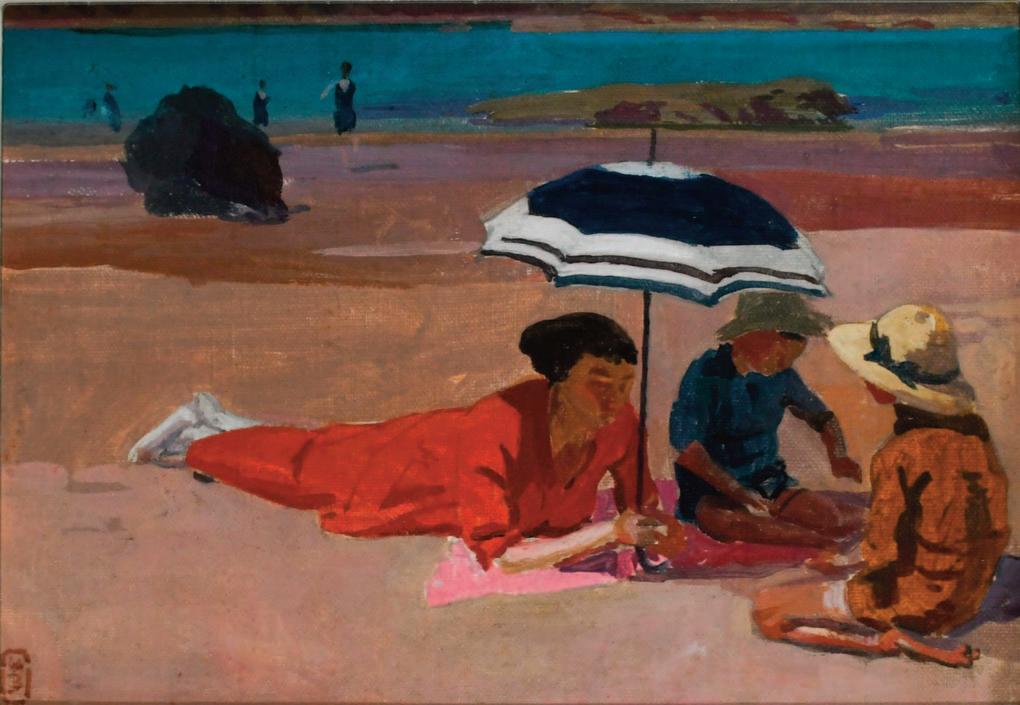
Signed with monogram (lower left): WB Oil on canvas laid to card, 23 by 33.5 cm (9 by 13 ¼ ins)
Bayes’s exhibits at the first Camden Town Group exhibitions in 1911 received significant critical attention, The Daily Telegraph critic noting in D ecember of that year “There is something satisfying in the austere modernity of Mr Walter Bayes…. He is able to suggest beneath the aerial envelope, beneath the perpetually changing vesture of the earth, something of architectural structure, of permanence” (The Daily Telegraph, 14 December 1911, quoted in Wendy Baron, The Camden Town Group, Scolar Press, 1979, p.214). Critics went on to label Bayes as both a “Modernist” for the simplification of form (something in evidence in this painting) and a “Classicist” in respect of his concern for rhythm and design. The latter of these ultimately set him apart from other members of the Camden Town Group. Elegant coastal
subjects formed a significant part of the body of work he created at this date, including works such as The Glass Door which was shown at the Second Camden Town Group Exhibition in D ecember 1911 (no.51). One of his favourite locations were the beaches at or near Locquirec in Brittany where Bayes regularly holidayed with his family in the early 1910s. This is the likely subject of the present work. The model here can be clearly identified as Bayes’s wife, Kitty with their children. Their age would suggest a date of the early 1910s which also fits with the Breton subject matter. Paintings like this also show evidence of Bayes’s subdued but sometimes radical use of colour, notable in the blues and purples of the distant coast and (above all) the almost fluorescent pink of the beach towel
CAT. 25
Nora Summers (1892-1948)
With a further study for a family portrait (to the reverse of the panel)
Oil on panel, 32 by 48 cm (12 ½ by 18 ¾ ins)

Provenance: Anthony Devas
Summers studied at the Slade School of Art from 1907 until 1910, marrying Gerald Summers (who she had met there) in 1912. She came to be associated with Augustus John and his circle (including J.D.Innes and Derwent Lees) and she was a regular visitor to the John family at Alderney Manor from around 1914. Early works like this are strongly influenced by John's own vibrantly colourful oil sketches of his family from around the same date
CAT. 26
Henri Gaudier-Brzeska (1891-1915)
Stamped: hGaudierBrzeska and numbered 5/12 underneath the sculpture Composite stone, height 18 cm (7 ins)
Provenance: Kettle's Yard, Cambridge, U.K., acquired by the present owner in 1966
Literature: Harold Stanley Ede, A Life of Gaudier-Brzeska, London, 1930, p. 204; Roger Cole, Burning to Speak: The Life and Art of Henri GaudierBrzeska, Oxford, 1978, cat. no. 13, p. 60; Evelyn Silber, Gaudier-Brzeska. Life and Art, London and New York, 1996, cat. no. 103, pp. 274-5 (dated 1914)
Gaudier-Brzeska made numerous drawings and sculptures of animals in his short career, drawing on a wide range of influences from the art of Africa and Polynesia to Constantin Brancusi who he admired for his purity of form. This sculpture was originally conceived between 1912 and 1914 and
it was cast in composite stone in an edition of twelve by J.S.Ede at Kettle's Yard in the mid 1960s. This is number five from that edition with other casts belonging to Cambridge University, the Tate Gallery and the Musee Nationale d'Art Moderne at the Pompidou Centre in Paris.
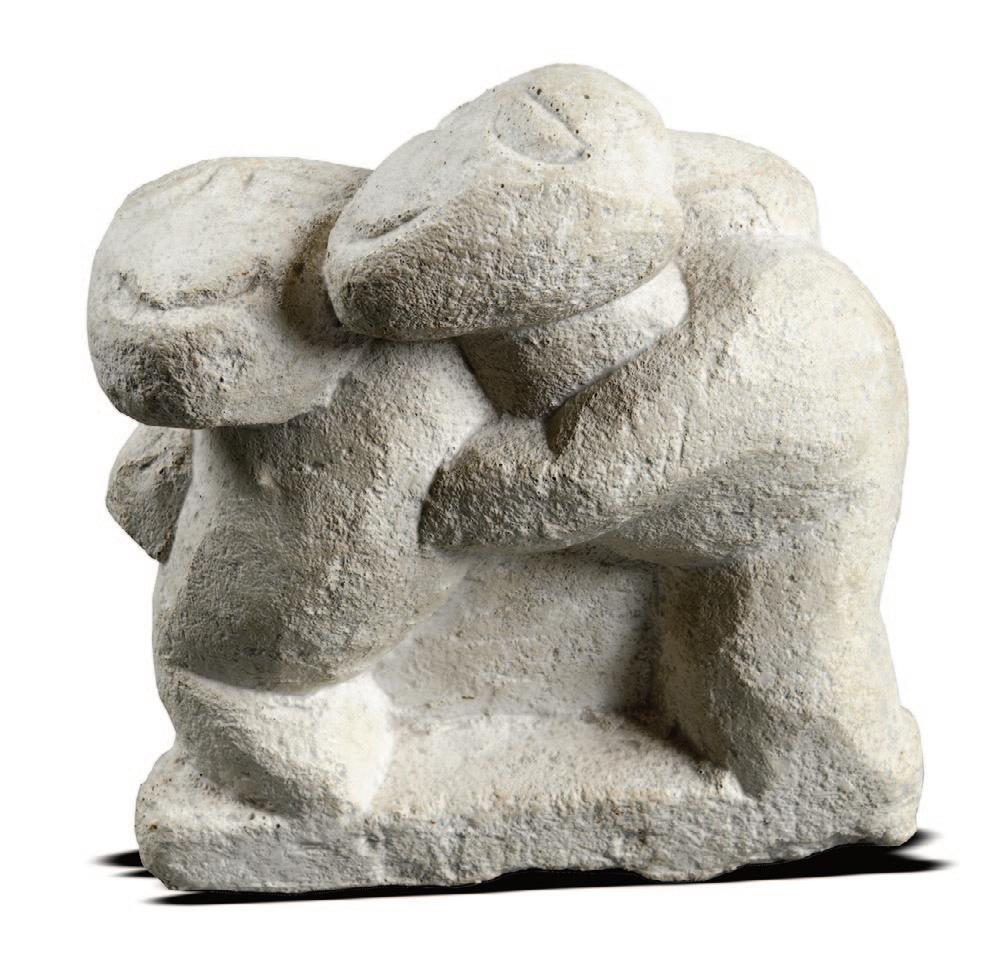
CAT. 27
Signed and dated in the bronze:
C.Wheeler/1916
Bronze with a mid/light brown patina on a marble plinth, 14 cm (5 ½ ins) (16.5 cm (6 ½ ins) including base)
This sensitive and moving maquette dates from the end of the artist’s time as a student at the Royal College of Art. In the following decades Wheeler would develop a reputation as a highly decorative architectural and portrait sculptor but this early piece is firmly in the tradition of the British New Sculpture movement, whilst strongly displaying the influence of Auguste Rodin. It is also hard to escape the context of the work’s creation, during arguably the most difficult year of the First World War. Having been declared unfit for active service, Wheeler worked instead on modelling artificial limbs for Wartime amputees. He later rose to become the first sculptor to serve as president of the Royal Academy in the institution’s history, a role he held from 1956 until 1966.
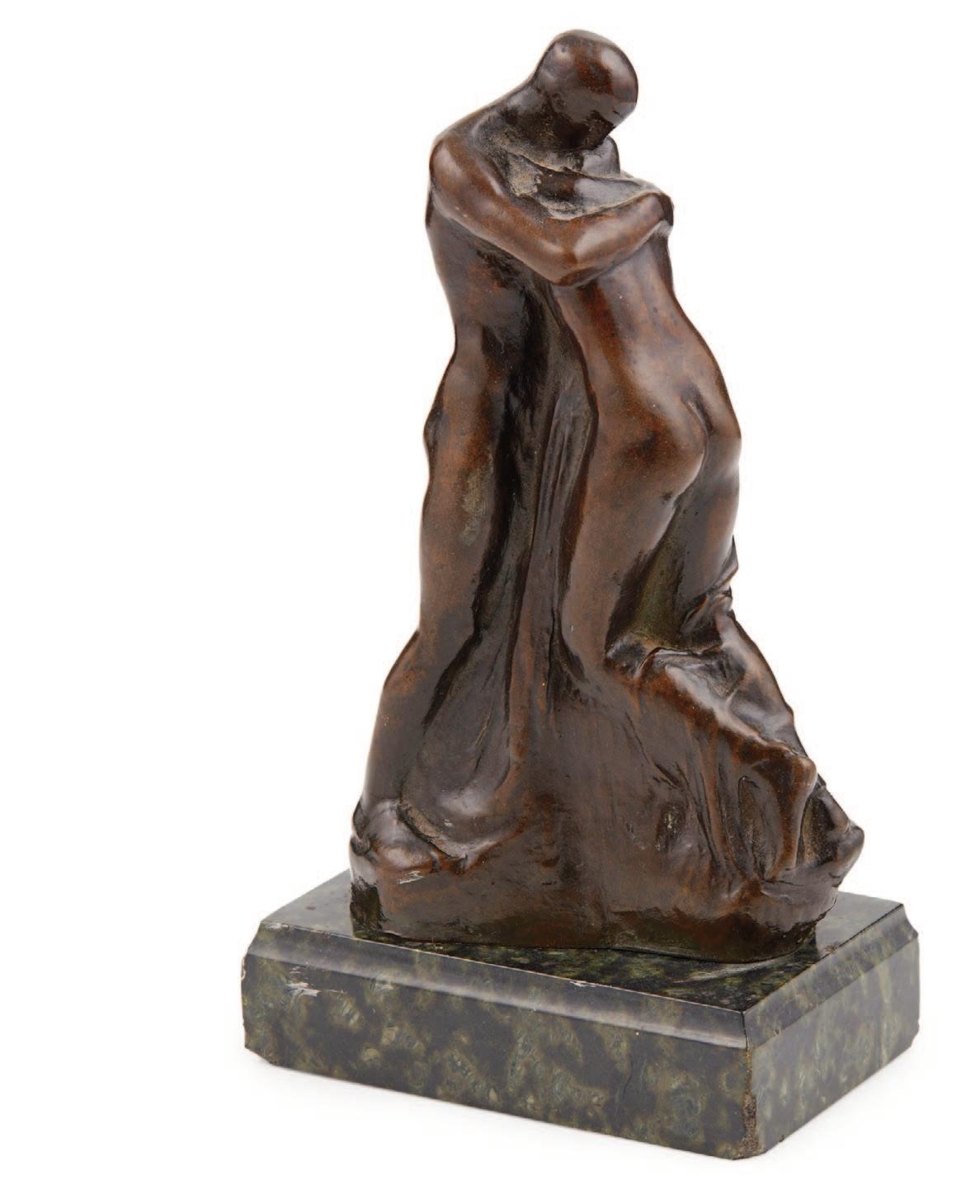
CAT. 28
Rupert Lee (1887-1959)
The Shell, 1918
Watercolour, 9 ¾ by 7 ¾ ins (25 by 19 5 cm)
Literature: Denys Wilcox. Rupert Lee, Painter, Sculptor and Printmaker, Sansom & Co., 2010, p.46-47, illustrated fig.34 (p.48) and on the book’s front cover
Lee’s Wartime masterpiece, The Shell was executed using ideas from the artist’s sketchbooks and is his own tribute to the ordinary “fighting Tommy”. The work contains elements of cubism and a bold stylisation which contribute to create an iconic work by an artist-soldier fighting on the Western Front. Denys Wilcox has written of the present work: “Overall the painting is a near perfect symbol of the March retreat of 1918, portraying the ever resilient, battle-weary, Tommy on the run and at breaking point.” (op.cit.p.47).
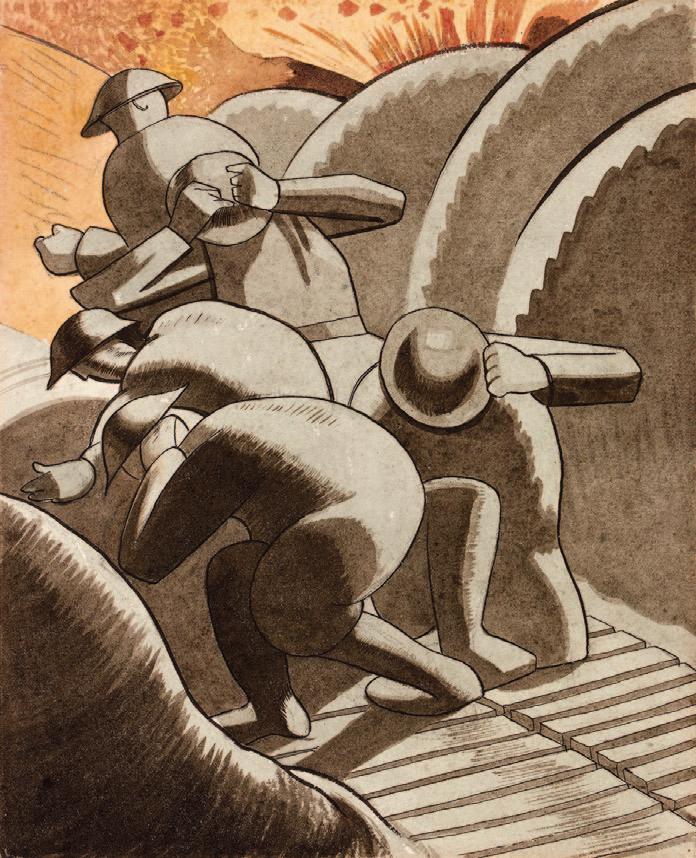
CAT. 29
Maurice Lambert, RA (1901-1964)
Parachutists, 1919
Signed and titled l l.: M. P. Lambert and dedicated and dated lower left to Penelope
Spencer June 9th 1919
Watercolour over ink on paper, 55 by 37 cm (21 ½ by 14 ½ ins)
This powerful work was painted just at the end of the First World War when Lambert was working in the studio of the sculptor Francis D erwent Wood (1871-1926). Its visceral response to the War owes much to the Vorticist movement and the style of the Italian Futurists which had flourished in Europe in the previous few years and little to the restrained Classicism of D erwent Wood. It does however anticipate Lambert’s own move towards modernism and his association in the 1930s with artists such as Barbara Hepworth and Henry Moore in the Seven and Five Society. The painting’s dedicatee, Penelope Spencer, was a leading ballerina of her era and friend of Lambert’s brother, the composer Constant Lambert.
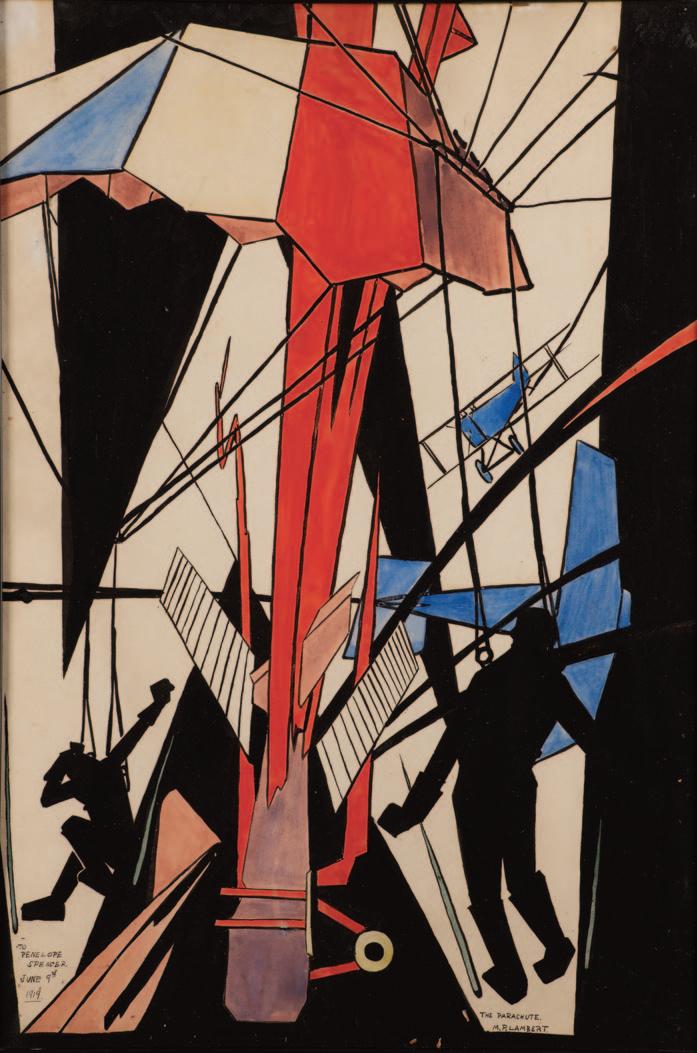
CAT. 30
Dora Carrington (1893-1932)
The Road to Hurstbourne Tarrant
Pencil, 26 by 23 cm (10 ¼ by 9 ins)
Provenance: originally a page from a sketchbook of the artist from c.1914 acquired by the Bloomsbury Workshop, Phillip’s 17 September 1991, lot 57; acquired by the previous owner from The Bloomsbury Workshop in March 2004
Exhibited: the Bloomsbury Workshop, London, Dora Carrington (1893-1932) – an exhibition of drawings and watercolours, September-October 1992 (catalogue introduction by Frances Partridge)
The Bloomsbury Workshop identifies this fluid landscape sketch as a roadway on the way to Carrington’s home at Hurstbourne Tarrant in Hampshire. Her parents had moved to Ibthorpe House on the edge of the village in 1914 and she set up a studio there soon after that. She had recently graduated from the Slade School of Art where she had been a multiple prize winner, forming part of an impressive group of fellow painters including Paul and John Nash and Mark Gertler.

CAT. 31
Paul Nash
(1889-1946)
Pond near Kimble, c.1919
Inscribed verso: Pond near Kimble and with further annotations and colour notes
Pen and ink with grey wash and pencil, 26 by 21 cm (10 ¼ by 8 ¼ ins)
This recently discovered drawing is one of a small but significant group of landscape pictures executed by Nash in and around the Buckinghamshire Chilterns in circa 1919 Identified drawings from this period include the landscapes Avenue in the Fields and Early Spring, Fulmer (see Andrew Causey, Paul Nash, Clarendon Press, Oxford, 1980, p.365 ff, nos.239 and 248), both of which employ the same graphic shading on the tree trunks and pathways as well light brush and ink work to suggest the bare early Spring branches. Much of his landscape work at this date was executed as a distraction from The Menin Road, the major war painting he was finishing for the British War Memorials Committee and arguably the artist’s landmark early masterpiece. Nevertheless, his landscape work at this date is far from insignificant and the motifs of clusters of trees, ponds and pathways through woodlands

remained strongly in evidence in his woodcuts, paintings and watercolours, as well as the work he did as an illustrator (for example in the Sun Calendar in 1920). Within a few years he would abandon the pen and ink work that underpin drawings such as these in favour of the application of purer watercolour.
Kimble near Princes Risborough in Buckinghamshire features as a location in a number of pictures by Nash at this date Most of these are (significantly) also landscapes with ponds. These include the eponymous landscape Pond at Kimble dated by Causey to 1921 (Private Collection, see Causey op.cit, p.376, no.324) and a later oil from c.1924 based on this subject known as The Pond (Private Collection, see Causey op.cit. p.386, no.428).
CAT. 32
Claude Flight (1881-1955)
Speed
Signed in pencil u l.: CLAUDE FLIGHT
Linocut printed in cobalt blue, yellow ochre, vermilion and Prussian blue, 1922, on buff oriental laid paper, with margins 22.6 cm by 28.8cm (9 in by 11 ¼ ins)

Literature: Stephen Coppel, Linocuts of the Machine Age, Scholar Press, London, 1995, p74.
Flight’s linocut Speed is arguably one of the most significant British prints of the early twentieth century, assimilating some of the influence of the Vorticists in the previous decade into a style that would pave the way for the linocuts of the Grosvenor School in the same decade. The present work was used as the frontispiece to Flight's first linocut textbook, Lino-cuts: A Hand-book of Linoleum-cut Colour Printing (1927). This print was impressed on the reverse of the sheet, the colours showing through the fine translucent paper.
CAT. 33
Albert Edward Halliwell
(1905-1987)
Signed l.r.: A.E.Halliwell and with number label (under mount): 49
Gouache over pencil, 51 by 32 cm
(20 by 12 ½ ins)
Halliwell’s ingenious design, a poster idea for Southern Railway, is a fine example of how commercial artists adopted some of the visual ideas in evidence in Vorticism in the previous decade into a distinct visual language of their own. The artist cleverly incorporates the representational elements of imagery associated with train travel and the seaside (even incorporating associated colouring into the text) into an extremely effective abstract design. Halliwell, a noted designer of the period, created work for London Transport, as well as a number of British Railway companies. He was a prominent teacher in London art schools from the 1930s, including Bromley and Beckenham, taking up a post at Camberwell School of Art in 1948.

CAT. 34
Walter Sickert, RA (1860-1942)
Oil on canvas, 61.5 by 41 cm. (24 ¼ by 16 in)
Provenance: the Wyndham Vint Collection, Bradford; Christie's, London, 11 July 2013, lot 124; Private Collection, U.S.A.
Exhibited: Whitechapel Art Gallery, London, Wyndham T.Vint’s Collection of Oil Paintings, April-May 1939, n.149
Literature: Wendy B
ron, Sickert Paintings and Drawings,
Although originally identified as a Dieppe café scene prior to being shown to Wendy Baron in 1996 (see Baron, op.cit, p.457), the subject has subsequently been established as the casino at Dieppe, distinctive with its balloon-backed chairs and lowhanging fabric lampshades. The genesis for the important series of paintings that Sickert made in the casino there came from the time he spent observing gamblers playing Baccarat, Sickert sketching them in secret on small cards or scraps of
paper, usually concealed under the casino tables as he made them. The present work is one of Sickert’s rarer surviving larger oil sketches for the subject. The painting originally belonged to the Bradford collector Wyndham Vint who assembled a remarkable collection of British art between the Wars and was the owner of a significant number of important works by Sickert.

CAT. 35

Pine Trees, Hampstead Heath, 1925
Signed l.r.: C.Ginner
Oil on canvas, 43 by 55 cm (17 by 21 ½ ins)
Provenance: acquired by Viscountess Helburn at the Goupil Gallery in 1925; acquired by the previous owners at the Fine Art Society, New Bond Street, in 2011
Exhibited: Goupil Gallery, London, November-December 1925, no.37; Fine Art Society, London, Camden Town Group Centenary Exhibition, June-July 2011, no.22
Ginner lived for most of his later life on Hampstead High Street and the immediate area including Flask Walk opposite and the Heath itself feature as a subject in many of his London pictures. Having been a founder member of the Camden Town Group in 1911 and a leading light in the London Group that grew out of it, Ginner went to have a longer and (at times) more successful artistic career than many of his
contemporaries. Along with Harold Gilman he wrote a manifesto in 1914 in which they coined the term “Neo-Realism ” – a form of painting characterised by a rigorous observation of nature. It was this that came to define his work. Ginner’s paintings are notable for their thick use of impasto which helps in conveying the texture, colour and tone of their subject.
CAT. 36
Henry Lamb, RA (1888-1960)
Punts on the Cam at Cambridge,
Signed l l.: Lamb/25
Oil on panel, 40 by 51 cm (15 ¾ by 20 ins)
1925
Provenance: probably acquired from Lamb by his patron J.L.Behrend in the mid 1920s; sold to the previous owners at the Leicester Galleries in 1962
Literature: London, Leicester Galleries, The J.L. Behrend Collection, May 1962, no.12
Lamb’s strong links with Cambridge began with visits to his brother Walter whilst the latter was an undergraduate there. Later he would spend time in the city with his friend Lytton Strachey and as a more established artist he would become one of the painters of choice for Cambridge dons and college masters (this would include in 1926 a portrait of Lytton Strachey’s sister Joan Pernel Strachey who was Principal of Newnham College). Although appreciative of its architecture which he referred to as “much more beautiful than anything in Oxford”, he also tired of numerous trips there and complained of “the old dons…grumbling and sighing”. The present landscape is a rare example of Lamb’s work in the city that took him beyond the drudgery of the portrait commission.
It depicts the punt station off Mill Lane on a bend of the River Cam just beyond Queen’s College. At this date Lamb was living in Poole, a period that accounted for a small but fine group of cityscapes, many taken from the upper floor of his house in the heart of the old harbour and looking down on to its narrow streets below. This unusual viewpoint translated to the canvas producing an oblique quality in the perspective of his compositions that recalls the work of Stanley Spencer who was very close to Lamb at this date. There is a similar element to the perspective in the present painting, notably punctuated by the placing of the punts across the flat plane of the riverbank below.

CAT. 37
Alfred Wolmark (1877-1961)
Market scene, Tunis
Signed and dated l l.: Wolmark/27
In a highly decorative period carved-wood frame
Oil on canvas, 63 by 76 cm (24 ¾ by 30 ins)
Provenance: with the Fine Art Society in the mid 1970s
Exhibited: Ferens Art Gallery, Hull, Alfred Wolmark Exhibition,
Wolmark remains one of the great neglected émigré artists to be working in Britain in the first few decades of the twentieth century. His early work bears homage to his Jewish heritage and there is a strong decorative element to his later portraits. It is through two female friends who Wolmark met in Paris that he decided to visit Tunis, arriving in the city in early December 1926. The city was to have a profound impact on the artist who was struck by the poverty and basic conditions of the place but also greatly affected by the city’s exotic colour:
“You have no idea how picturesque those Arab and Jewish women are, full of colour, colour such that even I could not dare before” (from a letter to the artist’s wife Bessie).
That sense of colour and exoticism touches on the fine body of work he created there, most of which depicts the city’s Jewish ghetto and larger Arab population. Some of the sitters in Market Scene, Tunis one of the most significant works he produced there, can be identified in smaller portraits and other subject pictures from the same date. Here Wolmark reminds us of his genius in imbuing his subjects (in this case the Arab crowd) with a strong sense of both humanity and monumentality – the same qualities he had displayed in his earlier paintings of Jewish life. We are grateful to Peter Risdon for his assistance.
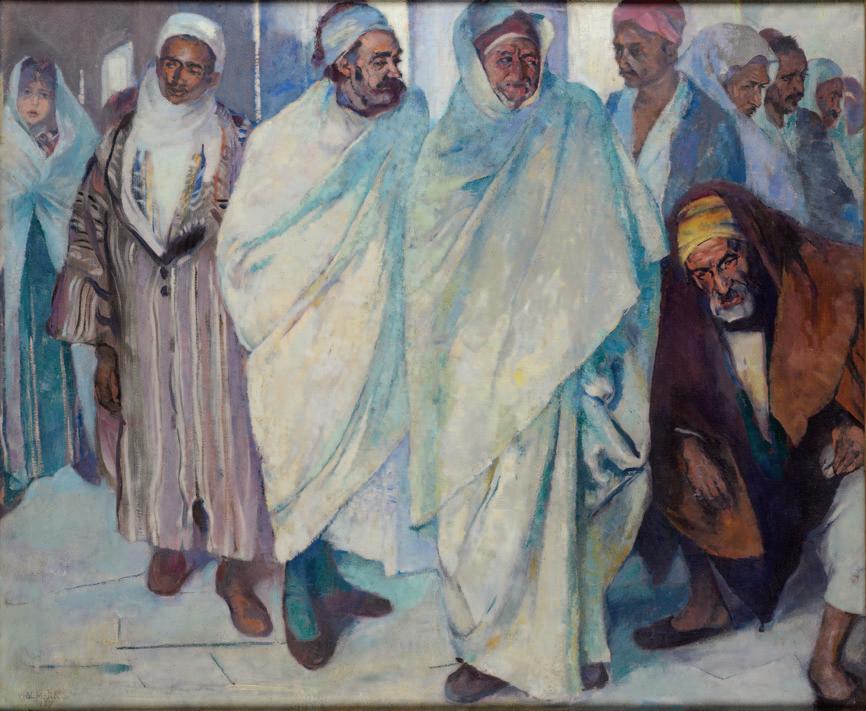
CAT. 38
William Matthews (1885-1962)
Early Evening, Tarbet Fair
Oil on canvas, 30 5 by 26.5 cm (12 by 10 ½ ins)

Matthews exhibited views of Tarbet at the New English Art Club in 1928 and the Royal Academy in 1943. The present painting of the annual fair held there probably dates from the mid to late 1920s. Matthews was a teacher in London at Regent Street Polytechnic, but was born in Aberdeenshire where he started working life assisting his father on their family farm. He was a regular exhibitor at the Royal Academy but never forgot his roots, with Scottish subjects forming the majority of his public exhibits.
Left: [Detail of cat.38]

CAT. 39
Watercolour, 30 by 44.5 cm (12 by 17 ½ ins)
Many of Webb’s most successful woodcuts depict the Northumbrian countryside near Hadrian’s Wall where he would visit regularly in the inter-war years. His best watercolours, like this picture, closely reflect his work as a printmaker and retain something of the same graphic quality and inventive composition. Webb was a leading figure in the British wood engraving revival of the 1920s and was highly regarded as an illustrator, with work including that for the Golden Cockerel Press and later for a famous edition of Swallows and Amazons. He taught at Birmingham School of Art in the 1920s, later lecturing on engraving in London at St Martin’s School of Art.

Roland Vivian Pitchforth, RA (1895-1982)
Hillside village in the Pennines
Signed and dated l.r.: Pitchforth/27
Oil on canvas, 64 by 79 cm (25 ¼ by 31 ins)
In the years following his graduation from the Royal College of Art, Pitchforth painted a number of landscapes of the Pennines and West Yorkshire, which, like the present work are highly individual depictions of the countryside he loved from his childhood and student days. His work in oil at this date shows the influence of Cezanne and displays a strong sense of structure and composition, characteristics that are evident in much of the best representational British painting of the interwar years. In the years following the war Pitchforth almost completely abandoned oil painting in favour of a looser style of watercolour painting for which he is probably best known.

Oil on canvas, 18 by 28 cm (7 by 11 ins)

Provenance: Sotheby's, Modern British and Irish Art, 6 March 1996, lot 210
Like Pitchforth, the slightly younger Richard Eurich created most of his earlier landscape work in Yorkshire, having been a student at Bradford School of Art in the early to mid 1920s. The present work is listed in the online catalogue of the work of Richard Eurich where it is dated to the 1920s. It is likely that the painting depicts an as yet unidentified Yorkshire subject. Although the artist would only commit purely to painting in oil well after his graduation from the Slade School of Art in 1926, early works like these are evidence of his natural facility and confidence in the medium.
CAT. 42
Richard Eurich, RA (1903-1992)
Scene on a Street, Lyme Regis
Signed and dated l l.: R.Eurich/1930
Oil on canvas, 16 by 20 ins (41 by 51 cm)
Provenance: with Redfern Gallery, London, 15 November 1932; T.W.Spurr, Bradford
Exhibited: Morecambe, British Institute of Adult Education, Art and Technical School, Loan Exhibition of British and French Paintings, June 1939; Manchester, Altrincham Libraries Museum and Art Galleries, no.14; Lyme Regis Museum, Serendipity, Nov 2014-March 2015
Eurich’s early mature work frequently possesses a mysterious narrative quality that can lend his subject matter a particular sense of surrealism. Painted in 1930, only just after the artist had decisively turned his focus from drawing to painting in oil, the present work depicts a house now called Dorset House (formerly Gibraltar Lodge) at the junction of Pound Road and
Silver Street in Lyme Regis. It is one of the earliest works the artist exhibited with the Redfern Gallery, with whom he would enjoy a highly successful twenty five year partnership. The painting just pre-dates Eurich’s own time living in the Dorset coastal town between 1932 and 1933.

CAT. 43
Clifford Ellis (1907-1985) and Rosemary Ellis (1910-1988)
Chanter's Folly and Dry Dock, Appledore
Signed and dated l.r.: C & RE/37
Gouache, 43 by 73 cm (17 by 28 ¾ ins)
The present work is Clifford and Rosemary Ellis’ complete finished design for the now iconic late 1930s Shell poster, Chanter’s Folly and Dry Dock Appledore. That work would be published in 1937 and in line with the printing process, this design is executed in the exact reverse of the final poster.

The subject shows the tower known as Chanter’s Folly that stood above Newquay Dock in Devon.
The folly was demolished in 1952.
CAT. 44
Dorothy Coke, RWS (1897-1979)
New Buildings, Brighton, 1930
Signed and dated l.r.: Dorothy J.Coke/1930 and inscribed with title (to reverse of canvas) Oil on canvas, 62 by 75 cm (24 ¼ by 29 ½ ins)
Exhibited: London, New English Art Club, 193
Dorothy Coke was the youngest artist considered for employment by the British War Memorials Committee following the end of the First World War. Two of her works were featured in the Imperial War Museum hang of its collection following refurbishment in 2014. A Slade student, Coke was most strongly associated with Brighton and taught at the college of art there until her retirement in the late 1960s. This view of the city from 1930 is evidence of the remarkable clarity seen in her early work, as well as a tendency to focus on unconventional elements of the picturesque

CAT. 45
Hubert Finney (1905-1991)
Storm Clouds over Rye Harbour, 1938
Signed, dated and inscribed with title l.r.: H.A.Finney/1938/Rye Harbour Kent Watercolour, 34 by 53 cm (13 ¼ by 20 ¾ ins)
Provenance: the artist's son
Finney entered the Royal College of Art in the late 1920s where he became part of a circle that included Barnett Freedman and Percy Horton. Like many students there at this date he fell under the influence of Paul Nash who had taught design at the college a couple of years earlier. The present work strongly recalls Nash’s own coastal scenes, including his beach scenes at Dymchurch (not far from Finney’s location here, at Rye) in the earlier 1920s.

CAT. 46
Paul Nash (1889-1946)
Signed l l.: Paul Nash and inscribed with colour notes
Lightly squared for transfer
Watercolour over pencil and black crayon, 17.5 by 25 cm (7 by 9 ¾ ins)
Provenance: with the Redfern Gallery in 1935 where acquired by Thomas Barnard
Exhibited: the Redfern Gallery, Paul Nash, April 1935, no.38

Literature: Andrew Causey, Paul Nash, Clarendon Press, Oxford, 1980, p.435, no.870
Although Causey (op cit) dates the present watercolour to 1935, it can be assumed that this was transcribed from Nash’s 1935 Redfern Exhibition (where it was shown as no.38) rather than from any first-hand inspection. The watercolour is evidently the full compositional study for Nash’s painting Whiteleaf Cross (now in the Whitworth, Manchester (no.1979.2)). That painting dates from
1932 and is possibly the artist’s best-known view of a corner of Buckinghamshire that he began painting just after the end of the First World War. It was a place of great and enduring significance for both Paul Nash and his brother John.
Tim Barringer (op cit) refers to Lights o’London as “the most impressive work in a series of London night scenes that Cole produced during the 1930s”. Whistlerian in its arrangement of harmony and tone this fine nocturne gives us an unusual backstreet glimpse into the glamorous world of inter-war London life. The view down Glasshouse Street, allowing us a glance at the north eastern edge of Piccadilly Circus is relatively unchanged. The Bodega bar is now The Glassblower Tavern whilst the Café Royal Brasserie, the sign to which is lit up on the right hand side of the painting is still there today as part of the Hotel Café Royal on the other side of the same block on Regent Street.
CAT. 47
Rex Vicat Cole (1870-1940)
Lights o’ London –Glasshouse Street by Piccadilly Circus
Signed and dated 1933 l.r.;
signed, inscribed with title and the
artist address on the stretcher
Oil on canvas, 101.5 by 72 cm.,
39 ½ by 28 ¼ in.
Exhibited: Royal Institute of Painters in Oil, Autumn 1933; Portsmouth Museum & Art Gallery, The Cole Family, Painters of the English Landscape, 1838-1975,
1988 no.124
Literature: T.J.Barringer, The Cole
Family: Painters of the English Landscape
1838-1975, Portsmouth City Museums
1988, p.158-159, p.163 (no.124)

CAT. 48
Douglas Percy Bliss (1900-1984)
Farmyard with Haycart
Signed l.r.: D.P.Bliss
Oil on canvas, 77.5 by 103 cm (30 ½ by 40 ½ ins)
Exhibited: Royal Academy, 1937, no.134
The 1930s coincided with a revival of farming and rural subjects in work by a number of British painters, much of which were nostalgic evocations of a rustic world that was fast disappearing under the effects of mechanisation. Such subjects were exhibited to great acclaim at the Royal Academy Summer exhibitions in the middle of the decade, with well-known examples including those by Gilbert Spencer and James Bateman (the latter of whom was the son of a farmer). Bliss’s
painting is strongly in this tradition and was itself exhibited at the Royal Academy in 1937. Bliss, who had been a direct contemporary of Eric Ravilious and Edward Bawden at the Royal College of Art was a leading wood engraver of the 1920s and 1930s and rose to become principal of Glasgow School of Art. Rural subjects like these are common in his later work in particular, often painted in the area of Derbyshire where he settled and spent the summer months.

CAT. 49
Charles Mahoney, RA (1903-1968)
Borough Green Railway Station, Kent
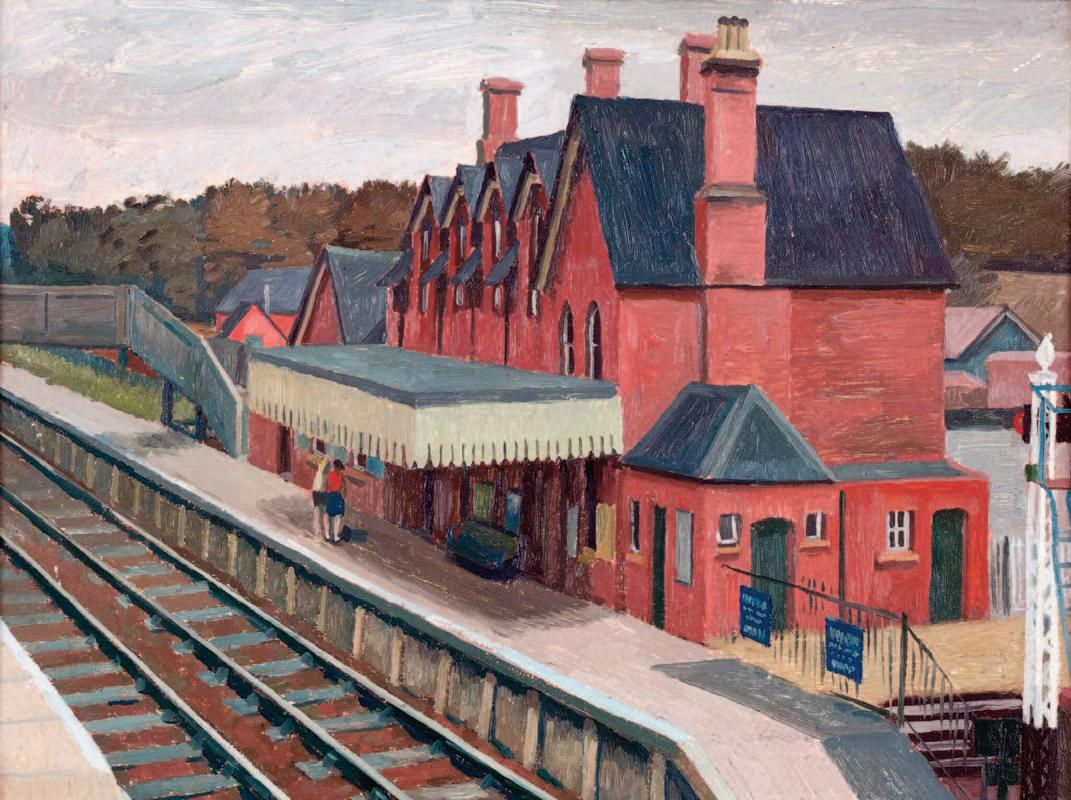
Oil on board, 30 by 40 cm (11 ¾ by 15 ¾ ins)
Provenance: Artist's Estate
Mahoney bought Oak Cottage at Wrotham in Kent in 1937 and for most of the last few decades of his life it (and more particularly its garden) provided his primary artistic inspiration. His local railway station was Borough Green, just a couple of miles up the road. In the 1930s Mahoney created impressive murals collaborating with artists like Edward Bawden, Eric Ravilious and Evelyn Dunbar (the former of whom were exact contemporaries at the Royal College of Art). Mahoney later joined the teaching staff there and is one of the sitters in Rodrigo Moynihan’s celebrated group portrait of the college’s painting department in 1951.
CAT. 50

Signed l.r.: Jessie Bayes Tempera on board, 42 by 33.5 cm (16 ½ by 13 ¼ ins) fig.1.
Bayes exhibited her first painting in tempera at the Royal Academy in 1935 –that work was also a floral still life. Jessie was from a talented artistic family that included her brothers, the painter Walter (see cat.24) and the sculptor Gilbert Bayes (for a phototograph of the three siblings see fig 1. opposite). Their father was the painter Alfred Bayes. Jessie was a specialist in miniature painting, becoming a member of the Royal Society of Miniature Painters in 1906. She also executed some fine work in illuminated manuscript and stained glass. Her work was highly decorative in quality and strongly influenced by the Arts and Crafts Movement.
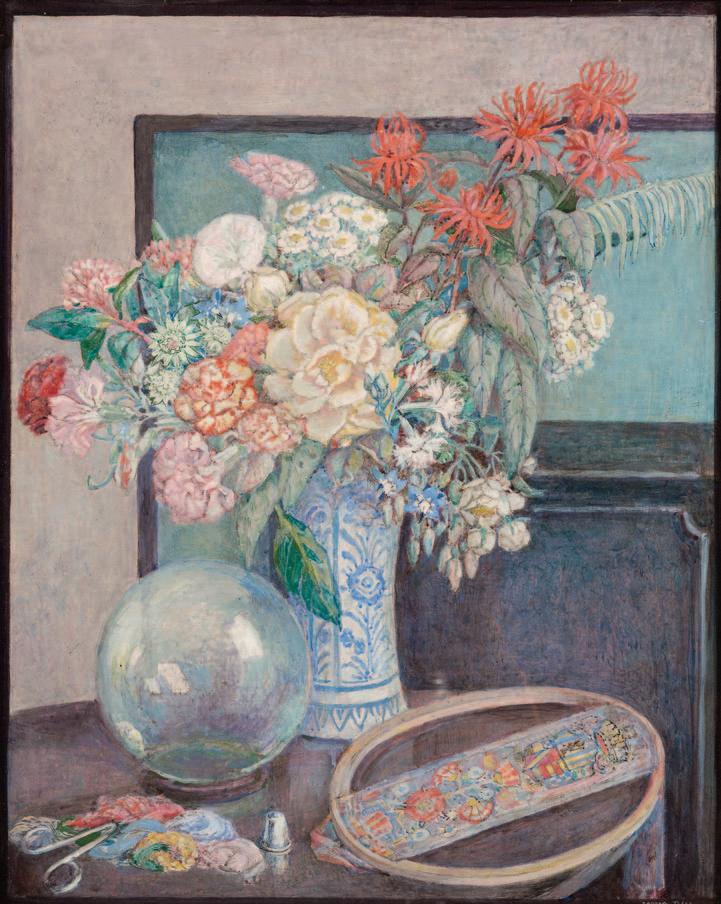
CAT. 51
Henry Lamb, RA
960)
Study for “The Artist's Family”, c.1943
Lightly squared for transfer
Oil on canvas, 51 by 40 cm (20 by 15 ¾ ins)
Provenance: acquired directly from the artist’s widow Pansy by Lord and Lady Shuttleworth, thence by descent
Exhibited: Salisbury Museum, Wiltshire, Henry Lamb - Out of the Shadows, May-September 2018, no.44
Literature: Harry Moore-Gwyn, Henry Lamb - Out of the Shadows, Paul Holberton, 2018, pp.104105 (illustrated full page in colour p.105); Mary Chamot, Dennis Farr and Martin Butlin, The
Modern British Paintings, Drawings and Sculpture, Tate Gallery, London 1964, vol.I (the present painting referred to in catalogue entry for the Tate picture)
The present work is probably Lamb's final study for his ambitious family group The Artist's Family which he worked and re-worked from 1940 until 1943. The painting was eventually acquired by the Chantry Bequest and presented to the Tate gallery in 1961, a year after artist's death.
Depictions of the painter's own family are at the heart of Lamb's later work as an artist and he painted numerous portraits of his second wife Pansy, often idealising her role as a mother, as well as other studies of his three children, often at play. The Artist's Family is particularly rare in being a complete family group, one that also includes a self portrait. From left to right, the painting shows the artist's two daughters, Henrietta (b.1931) and Felicity (b.1933) with Pansy holding the couples' only son, Valentine (b.1939). Lamb himself is seated at a clavichord, his back enigmatically turned away from the viewer. It is a device he used elsewhere, most significantly in his 1926 interior scene The Tea Party (private collection) showing Stanley Spencer and other guests at Lamb's table in Poole

CAT. 52
Gilbert Spencer, RA (1892-1979)
Signed l.r.: Gilbert Spencer
Oil on canvas, 35 by 46 cm (13 ¾ by 18 ins)

Provenance: a gift from the artist to Professor Ernest de Selincourt of Ladywood
Gilbert Spencer stayed with Ernest de Selincourt at his Lake District villa, Ladywood, at Christmas in 1942 and appears to have executed this painting during his time there. He also executed two drawings of members of de Selincourt's family in the same visit. Spencer lived in Ambleside during the Second World War following the Royal College of Art's evacuation there in the early 1940s. He was a member of the college's staff at the time
CAT. 53
Sir Lawrence Gowing, RA (1918-1991)
Boy, 1941
Oil on canvas, 30 by 30 cm (12 by 12 ins)
Provenance: Anthony Devas
Exhibited: Serpentine Gallery, London, Lawrence Gowing, Spring-Summer 1983, no.17
Literature: Catherine Lampert et al, Lawrence Gowing, Arts Council of Great Britain Exh.cat, 1983, p.16 (illustrated in black and white)
During the War Gowing moved to the village of Chilton Foliat on the Old Bath Road just over the boundary of Wiltshire. In the studio here he painted still life subjects and a number of portraits including this head study of a boy from the village. Gowing describes this in his text for his 1983 Arts Council show: “There were the first pickings of cooking apples, of which I painted fourteen in the next five years… There was a boy from the village, who sat equally still” (op.cit, p.16).

CAT. 54
Victor Pasmore, CH, RA (1908-1998)
Female Nude in an Interior, c.early 1940s
Signed with initials l.r.: VP and with the artist’s original handwritten label ‘To Lawrence thank you for having me’ Pencil, 24.5 by 15 cm (9 ¾ by 6 ins)
Provenance: a gift from the artist to his friend, the painter Sir Lawrence Gowing
Pasmore was a central figure in the formation of the Euston Road school in the late 1930s. The movement espoused realist painting based on close observation of the subject and is evident in the work of Pasmore as well as his contemporary William Coldstream and his pupil Lawrence Gowing.
Pasmore’s lyrical style at this date shows the influence of Whistler (particularly in his atmospheric landscapes and
cityscapes) as does the soft tonal quality evident in his interiors and life studies (of which this delicate pencil study is an example). Gowing was given this drawing by Pasmore and the two artists remained close friends. By the late 1940s Pasmore had moved towards the more purely abstract style for which he is perhaps best known today.

CAT. 55
Sir William Coldstream (1908-1987)
Woman in an Interior
Pencil with red crayon, 18 by 28 cm (7 by 11 ins)
Provenance: Sir Lawrence Gowing, directly from the artist
Lawrence Gowing who owned the present drawing was a close friend and disciple of Coldstream who he had studied under at the Euston Road School. Gowing cowrote the 1990 Tate publication on Coldstream’s paintings in which he referred to receiving a number of drawings from Coldstream on a visit to his studio. This included the present work and a portrait sketch of Gowing himself. This interesting drawing shows something of the artist’s fastidious working process and the strong sense of structure that underlines his larger paintings.

CAT. 56
Bernard Meninsky (1891-1950)
Woman in Blue
Oil on canvas, 76 by 51 cm (30 by 20 ins)
Painted in 1947, the present work is closely related to one of Meninsky's illustrations for John Milton's L'Allegro il Penseroso published by Allan Wingate in 1947.
Meninsky’s figure paintings of the 1940s were a late flowering in the artist’s career. Explicitly pastoral in subject and execution, they are Meninsky’s own take on the Neo-Romantic tradition that was so strong in British art of the period.

CAT. 57
Margaret Gere (1878-1965)
Farewells at Paddington Station
Signed and dated l l.: Margaret Gere/1948
Watercolour, bodycolour and pencil, 43 by 35cm (16¾ by 13¾ in)
Provenance: The Fine Art Society, London The Fortunoff Collection [7931]
Exhibited: Cheltenham, Cheltenham Art Gallery & Museums, Margaret Gere Exhibition, 21 January -3 March 1984, cat. no. D.
Gere studied under her brother Charles March Gere at Birmingham School of Art and much of her earlier work is influenced by him. Like her brother she was also a fine painter in tempera. She continued her studies at the Slade and was later a member of the New English Art Club and the Royal
Birmingham School of Art. This charming evocation of Paddington station has something of a stage-set quality, perhaps reflecting films of the later 1940s, in particular Brief Encounter that had been made a couple of years earlier.

CAT. 58
James Woodford, RA (1893-1976)
Dawn Chorus, 1946-47
Signed and dated 1946-7 and (titled on a label) Original plaster maquette, with a dark green finish, 43 cm (17 ins) high
Provenance: the artist’s estate; Liss Llewellyn Fine Art; Private Collection UK
Exhibited: Royal Academy, 1948, (1386), as Bird Group- Dawn Chorus, 1946-7, part of a Memorial to Esmond Carrick Simpson; City of Bradford Art Gallery, 1955 (744); WW2 – War Pictures by British Artists, Morley College London, 28 October -23 November 2016, cat 121.


More than twenty artists were commissioned by the WAAC to produce sculptures including Epstein, C.W. Dyson-Smith and Skeaping.
During World War II Woodford was camouflage officer to the Air Ministry. After the war he was responsible for a number of memorials including the outstanding War Memorial in the Court of Honour of the British Medical Association, (Tavistock Square, London, 1951).
Esmond Carrick Simpson was born in 1887 and died in 1942. There is no record of him having served in either WW1 or WW2 – given the dominant Dove motif in this memorial it is possible that Simpson was a Conscientious Objector. The Doves might equally refer to the restoration of peace at the point that this memorial was conceived (1946). The detail of the thrushes eating worms adds an unsettling note suggesting that Woodford intended perhaps a deeper hidden allegorical meaning within the composition. We are grateful to Liss Llewellyn Fine Art for their assistance

CAT. 59
James Woodford, RA (1893-1976)
Nereid – fountain group, circa 1947
Signed in pencil on the base Original plaster maquette, 49 cm (19 ½ ins) high
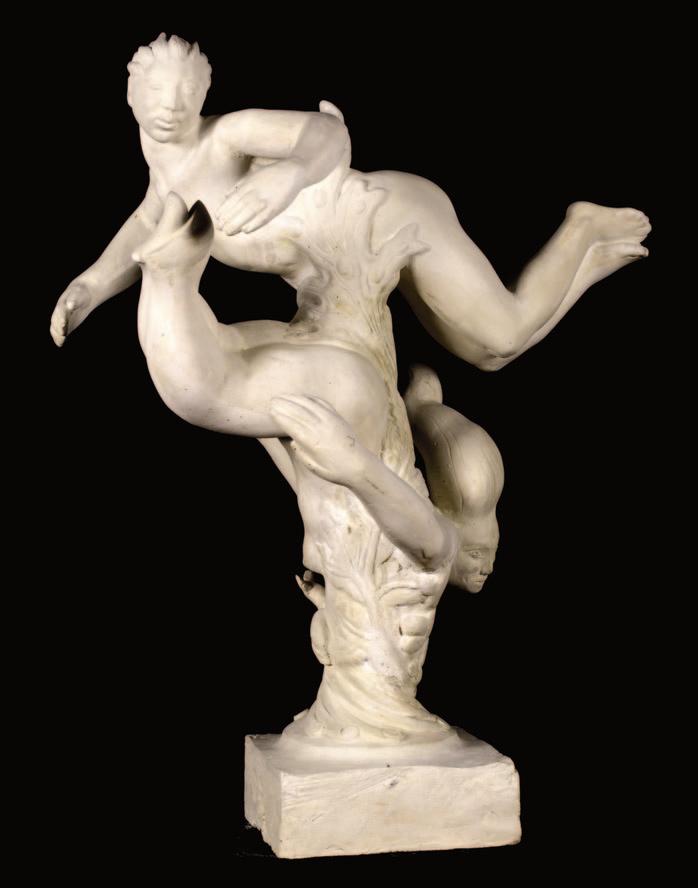


Provenance: The Artist’s son
A bronze version of this fountain group depicting the mythological sea nymphs known as the Nereids, was exhibited at the Royal Academy in 1947 (no.1273). The male figure in this group is most likely Nerites the handsome young sea god, brother of the Nereids. Alternatively, the male figure might be either Poseidon, who by tradition Nereid accompanied, or a sailor in distress, who by tradition Nereids were believed to help in perilous storms. We are grateful to Liss Llewellyn Fine Art for their assistance
John Nash, RA (1893-1977)
Winter Landscape from the Artist's House at Wormingford, Essex

Stamped with the artist's studio stamp (verso) and lightly squared for transfer
Oil on canvas board, 50 5 by 60 5 cm (20 by 23 ¾ ins)
Provenance: the artist's estate; New Grafton Gallery, where sold to Joanna Clack, Ipswich
John and Christine Nash moved to Bottengoms Farm in Wormingford on the Stour Valley in Essex in the early 1940s. The sparse landscape and East Anglian light greatly appealed to Nash and is a constant feature in his work over the next three decades. The writer Ronald Blythe who inherited the farmhouse from the Nashes later in life spoke of how Nash would retreat to Wormingford in the winter months and the winter landscapes and snow scenes that resulted from these prolonged periods are now considered amongst his finest later works. This viewpoint, taken from the artist’s upstairs studio window looking out towards the barn, is a composition that
(understandably for this reason) appears elsewhere in Nash’s work. Rarely however does it feature with such a blanket of snow – here so skilfully rendered with elements of the landscape suggested in a few dashes of paint over the white painted background that dominates much of the picture. Nash later said of his snow paintings: "Whenever it snowed...I would wait until the skies had clouded over and the light had become dim... That dull light brought out all the colours. Brick walls seemed to glow, the lichen on the trees looked that much richer."(quoted in Andrew Lambirth, John Nash, Artist & Countryman, Unicorn Press, 2019, p.253).


